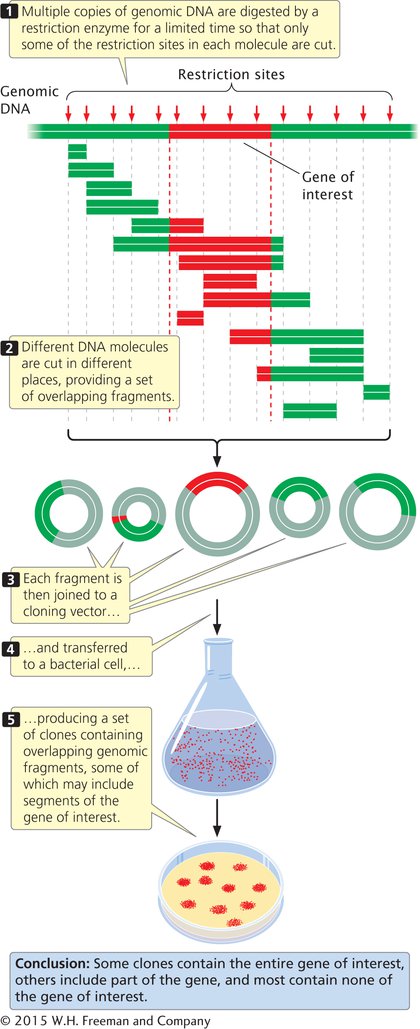DNA Libraries
A collection of clones containing all the DNA fragments from one source is called a DNA library. For example, we might isolate genomic DNA from human cells, break it into fragments, insert the fragments into vectors, and clone them in bacterial cells. The set of bacterial colonies or phages containing these fragments is a human genomic library, containing all the DNA sequences found in the human genome. In contrast, a cDNA library contains only DNA sequences that are transcribed into mRNA; a cDNA library is created from mRNA that is first converted into DNA and then cloned in bacteria.
CREATING A GENOMIC LIBRARY To create a genomic library, cells are disrupted, which causes them to release their DNA and other cellular contents into an aqueous solution, and the DNA is extracted from the solution. After the DNA has been isolated, it is incubated with a restriction enzyme for a limited amount of time so that only some of the restriction sites in each DNA molecule are cut (a partial digestion). Because which sites are cut is random, different DNA molecules will be cut in different places, and a set of overlapping fragments will be produced (Figure 14.9). The fragments are then joined to vectors, which can be transferred to bacteria. A few of the clones contain the entire gene of interest (if the gene is not too large), and a few contain parts of the gene, but most contain fragments that have no part of the gene of interest.

A genomic library must contain a large number of clones to ensure that all DNA sequences in the genome are represented in the library. A library of the human genome formed by using cosmids, each carrying a random DNA fragment from 35,000 to 44,000 bp long, would require about 350,000 cosmid clones to provide a 99% chance that every sequence is included in the library.
CONCEPTS
One method of finding a gene begins with the creation of a DNA library. A genomic library is created by cutting genomic DNA into overlapping fragments and cloning those fragments in bacteria. A cDNA library is created from mRNA that is converted into cDNA and cloned in bacteria.
SCREENING DNA LIBRARIES Creating a genomic or cDNA library is relatively easy compared with screening the library to find clones that contain the gene of interest. The screening procedure used depends on what is known about the gene.
The first step in screening is to plate the clones of the library. If a plasmid or cosmid vector was used to construct the library, the bacterial cells are diluted and plated so that each bacterium grows into a distinct colony. If a phage vector was used, the phages are allowed to infect a lawn of bacteria on a petri plate. Each resulting bacterial colony or plaque contains a single cloned DNA fragment that must be screened for the gene of interest.
A common way to screen libraries is with probes. To use a probe, replicas of the plated colonies or plaques must first be made. Figure 14.10 illustrates this procedure for a cosmid library.

How is a probe obtained when the gene of interest has not yet been isolated? One option is to use a similar gene from another organism as the probe. For example, if we wanted to screen a human genomic library for the growth-
Another method of screening a library is to look for the protein product of a gene. The clones can be tested for the presence of the protein by using an antibody that recognizes the protein or by using a chemical test for the protein. This method depends on the existence of an antibody or test for the protein produced by the gene. DNA libraries can also be screened using PCR or by sequencing.
CONCEPTS
A DNA library can be screened for a specific gene by using probes that hybridize to the gene. Alternatively, clones in a DNA library can be examined for the protein product of the gene.